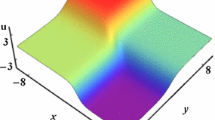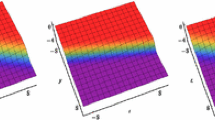Abstract
The \(b\)-family is a one-parameter family of Hamiltonian partial differential equations of nonevolutionary type, which arises in shallow water wave theory. It admits a variety of solutions, including the celebrated peakons, which are weak solutions in the form of peaked solitons with a discontinuous first derivative at the peaks, as well as other interesting solutions that have been obtained in exact form and/or numerically. In each of the special cases \(b=2\) and \(b=3\) (the Camassa–Holm and Degasperis–Procesi equations, respectively), the equation is completely integrable, in the sense that it admits a Lax pair and an infinite hierarchy of commuting local symmetries, but for other values of the parameter \(b\) it is nonintegrable. After a discussion of traveling waves via the use of a reciprocal transformation, which reduces to a hodograph transformation at the level of the ordinary differential equation satisfied by these solutions, we apply the same technique to the scaling similarity solutions of the \(b\)-family and show that when \(b=2\) or \(b=3\), this similarity reduction is related by a hodograph transformation to particular cases of the Painlevé III equation, while for all other choices of \(b\) the resulting ordinary differential equation is not of Painlevé type.
Similar content being viewed by others
References
A. Degasperis, D. D. Holm, and A. Hone, “A new integrable equation with peakon solutions,” Theoret. and Math. Phys., 133, 1463–1474 (2002).
A. Degasperis, D. D. Holm, and A. N. W. Hone, “Integrable and non-integrable equations with peakons,” in: Nonlinear Physics. Theory and Experiment II (Gallipoli, Italy, 27 June – 6 July 2002, M. J. Ablowitz, M. Boiti, F. Pempinelli, and B. Prinari, eds.), World Sci., Singapore (2003), pp. 37–43; arXiv: nlin/0209008.
A. Degasperis and M. Procesi, “Asymptotic integrability,” in: Symmetry and Perturbation Theory (Rome, Italy, December 16–22, 1998, A. Degasperis and G. Gaeta, eds.), World Sci., Singapore (1999), pp. 23–37.
R. Camassa and D. D. Holm, “An integrable shallow water equation with peaked solitons,” Phys. Rev. Lett., 71, 1661–1664 (1993).
B. Fuchssteiner and A. S. Fokas, “Symplectic structures, their Bäcklund transformation and hereditary symmetries,” Phys. D, 4, 47–66 (1981).
H. R. Dullin, G. A. Gottwald, and D. D. Holm, “Camassa–Holm, Korteweg–de Vries-5 and other asymptotically equivalent equations for shallow water waves,” Fluid Dynam. Res., 33, 73–95 (2003).
H. R. Dullin, G. A. Gottwald, and D. D. Holm, “On asymptotically equivalent shallow water wave equations,” Phys. D, 190, 1–14 (2004).
A. Constantine and D. Lannes, “The hydrodynamical relevance of the Camassa–Holm and Degasperis–Procesi equation,” Arch. Ration. Mech. Anal., 192, 165–186 (2009).
R. I. Ivanov, “Water waves and integrability,” Philos. Trans. R. Soc. London Ser. A, 365, 2267–2280 (2007); arXiv: 0707.1839.
D. D. Holm and A. N. W. Hone, “A class of equations with peakon and pulson solutions (with an Appendix by Harry Braden and John Byatt-Smith),” J. Nonlinear Math. Phys., 12, suppl. 1, 380–394 (2005).
A. Chertock, J.-G. Liu, and T. Pendleton, “Convergence of a particle method and global weak solutions of a family of evolutionary PDEs,” SIAM J. Numer. Anal., 50, 1–21 (2012).
R. Beals, D. H. Sattinger, and J. Szmigielski, “Multi-peakons and a theorem of Stieltjes,” Inverse Problems, 15, L1–L4 (1999).
R. Beals, D. H. Sattinger, J. Szmigielski, “Multipeakons and the classical moment problem,” Adv. Math., 154, 229–257 (2000).
H. Lundmark and J. Szmigielski, “Multi-peakon solutions of the Degasperis–Procesi equation,” Inverse Problems, 19, 1241–1245 (2003); arXiv: nlin/0503033.
H. Lundmark and J. Szmigielski, “Degasperis–Procesi peakons and the discrete cubic string,” Internat. Math. Res. Rap., 2005, 53–116 (2005).
A. N. W. Hone and J. P. Wang, “Prolongation algebras and Hamiltonian operators for peakon equations,” Inverse Problems, 19, 129–145 (2003).
A. N. W. Hone and S. Lafortune, “Stability of stationary solutions for nonintegrable peakon equations,” Phys. D, 269, 28–36 (2014).
J. Escher and B. Kolev, “The Degasperis–Procesi equation as a non-metric Euler equation,” Math. Z., 269, 1137–1153 (2011).
G. Misiołek, “A shallow water equation as a geodesic flow on the Bott–Virasoro group,” J. Geom. Phys., 24, 203–208 (1998).
A. N. W. Hone, “Painlevé tests, singularity structure and integrability,” in: Integrability (Lecture Notes in Physics, Vol. 767, A. V. Mikhailov, ed.), Springer, Berlin (2009), pp. 245–277.
A. V. Mikhailov and V. S. Novikov, “Perturbative symmetry approach,” J. Phys. A: Math. Gen., 35, 4775–4790 (2002).
V. P. Ermakov, “Second-order differential equations: Conditions of complete integrability,” Appl. Anal. Discrete Math., 2, 123–145 (2008).
D. D. Holm and M. F. Staley, “Nonlinear balance and exchange of stability in dynamics of solitons, peakons, ramps/cliffs and leftons in a \(1+1\) nonlinear evolutionary PDE,” Phys. Lett. A, 308, 437–444 (2003); arXiv: nlin/0203007.
D. D. Holm and M. F. Staley, “Wave structure and nonlinear balances in a family of evolutionary PDEs,” SIAM J. Appl. Dyn. Syst., 2, 323–380 (2003).
T. Tao, “Why are solitons stable?,” Bull. Amer. Math. Soc. (N. S.), 46, 1–33 (2009).
H. Inci, “On the well-posedness of the Holm–Staley \(b\)-family of equations,” J. Nonlinear Math. Phys., 23, 213–233 (2016).
L. Molinet, “A rigidity result for the Holm–Staley \(b\)-family of equations with application to the asymptotic stability of the Degasperis–Procesi peakon,” Nonlinear Anal. Real World Appl., 50, 675–705 (2019).
E. G. Charalampidis, R. Parker, P. G. Kevrekidis, and S. Lafortune, “The stability of the \(b\)-family of peakon equations,” arXiv: 2012.13019.
S. Lafortune and D. E. Pelinovsky, “Spectral instability of peakons in the \(b\)-family of the Camassa–Holm equations,” arXiv: 2105.13196.
A. N. W. Hone, “The associated Camassa–Holm equation and the KdV equation,” J. Phys. A: Math. Gen., 32, L307–L314 (1999).
R. Camassa, D. D. Holm, and J. M. Hyman, “A new integrable shallow water equation,” Adv. Appl. Mech., 31, 1–33 (1994).
Y. Matsuno, “The \(N\)-soliton solution of the Degasperis–Procesi equation,” Inverse Problems, 21, 2085–2101 (2005).
Y. A. Li and P. J. Olver, “Convergence of solitary-wave solutions in a perturbed bi-Hamiltonian dynamical system I. Compactions and peakons,” Discrete Contin. Dynam. Syst., 3, 419–432 (1997).
A. Constantin and H. P. McKean, “A shallow water equation on the circle,” Comm. Pure Appl. Math., 52, 949–982 (1999).
K. Okamoto, “On the \(\tau\)-function of the Painlevé equations,” Phys. D, 2, 525–535 (1981).
A. E. Milne, P. A. Clarkson, and A. P. Bassom, “Bäcklund transformations and solution hierarchies for the third Painlevé equation,” Stud. Appl. Math., 98, 139–194 (1997).
P. A. Clarkson, “The third Painlevé equation and associated special polynomial,” J. Phys. A: Math. Gen., 36, 9507–9532 (2003).
P. J. Forrester and N. S. Witte, “Application of the \(\tau\)-function theory of Painlevé equations to random matrices: \(\rm P_\mathrm{V}\), \(\rm P_\mathrm{III}\), the LUE, JUE, and CUE,” Comm. Pure Appl. Math., 55, 679–727 (2002).
L. E. Barnes, Integrable and non-integrable equations with peaked soliton solutions, (Ph.D. thesis), University of Kent (2020).
A. S. Fokas, “On a class of physically important integrable equations,” Phys. D, 87, 145–150 (1995).
P. J. Olver and P. Rosenau, “Tri-Hamiltonian duality between solitons and solitary-wave solutions having compact support,” Phys. Rev. E, 53, 1900–1906 (1996).
Z. Qiao, “A new integrable equation with cuspons and W/M-shape-peaks solitons,” J. Math. Phys., 47, 112701, 9 pp. (2006).
V. Novikov, “Generalizations of the Camassa–Holm equation,” J. Phys. A: Math. Theor., 42, 342002, 14 pp. (2009).
Funding
L. E. Barnes was supported by a PhD studentship from SMSAS, Kent. The research of A. N. W. Hone was supported by Fellowship EP/M004333/1 from the Engineering & Physical Sciences Research Council, UK, and is currently funded by grant IEC\R3\193024 from the Royal Society.
Author information
Authors and Affiliations
Corresponding author
Ethics declarations
The authors declare no conflicts of interest.
Additional information
Prepared from an English manuscript submitted by the author; for the Russian version, see Teoreticheskaya i Matematicheskaya Fizika, 2022, Vol. 212, pp. 303–324 https://doi.org/10.4213/tmf10238.
Rights and permissions
About this article
Cite this article
Barnes, L.E., Hone, A.N.W. Similarity reductions of peakon equations: the \(b\)-family. Theor Math Phys 212, 1149–1167 (2022). https://doi.org/10.1134/S0040577922080104
Received:
Revised:
Accepted:
Published:
Issue Date:
DOI: https://doi.org/10.1134/S0040577922080104




